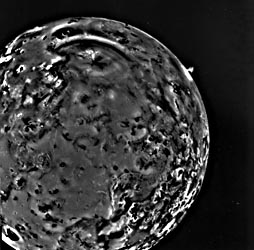 |
|---|
| Plate P-13 |
 |
|---|
| Plate P-13 |
The innermost of Jupiter´s large satellites, Io, deserves an entire caption. The Plate shows the full disk as Voyager 1 approached it; the three ancillary views cover regions included in the main view, with the same geographic orientation.
Io had been known to be peculiar for some years, but the first Voyager images astonished viewers. Apart from the bright orange colors, later proved by Young (1984) to be an artifact of the instrumentation, the terrain revealed was unlike that of any other planet or satellite. Most striking is the total absence of impact craters; Io is the only known solid body with none. This implies some type of rapid resurfacing process that must be obliterating impact craters, since cratering is obviously happening throughout the solar system now. The nature of this resurfacing process was quickly discovered when closeup views (Figure P-13.1) revealed unmistakable volcanic craters and flows. Even more surprising was the discovery by Voyager engineer, L. Morabito, of nine huge volcanic plumes (Plate P-13) coming from Io, which has turned out to be the most volcanically active body known. The fundamental cause of this activity is dissipation of tidal energy in Io. In a brilliant predictive paper, published just 3 days before the Voyager l/Jupiter encounter, Peale et al. (1979) demonstrated that Europa perturbs Io into an unusually elliptical orbit around Jupiter. This in turn raises heat-producing body tides in Io, which, they predicted, would generate intense volcanism.
| Figure P-13.1 | Figure P-13.2 |
|---|---|
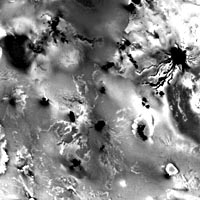 |
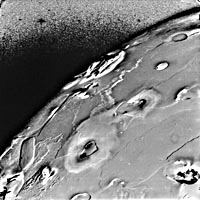 |
Geomorphically, the Ionian landscape appears to consist almost entirely of volcanic craters (patera), flows, or other volcanic deposits. The craters, such as those in Figure P-13.1 and P-13.2, tend to be relatively shallow and can best be termed "calderas." The lava flows resemble those on Earth. Because of their apparent reddish orange color, it was first believed that they were flows of elemental sulfur, which is red when initially melted. As mentioned previously, however, Young (1984) later showed that the true colors were chiefly pale yellows, and he argued convincingly that, although there is undoubtedly a flow of sulfur and sulfur dioxide on Io, the flows are not sulfur. These are thus landforms composed largely of silicate volcanics, as proposed by H. Masursky et al. (1979).
Much of the Ionian surface consists of plains with relatively low relief (Figures P-13.2 and P-13.3), clearly some type of volcanic deposits probably mantled with sulfur or sulfur dioxide. The total absence of impact craters indicates that the plains are extremely youthful, but it is not clear whether they formed from lava flows, pyroclastic deposition, or other processes. There is no doubt that at least some of the plains material is analogous to pyroclastic material, inasmuch as the huge volcanic plumes have been observed falling back onto the surface.
The origin of the topographic elevations, apart from the volcanoes, is even less clear. The angular mountains, such as Haemus Mons (Figure P-13.4), have relief of several kilometers and appear to be massifs or volcanic constructs of some sort. However, the mesas, composed of erosional remnants of layered plains (Figure P-13.2 and P-13.3) are even less understood. The most specific question is that of how their bounding scarps are produced (i.e., what the mechanism of slope retreat is). McCauley et al. (1979) have proposed that the scarps were produced by some type of sapping in which liquid sulfur dioxide plays a role analogous to that of water in terrestrial sapping. They interpreted the light-colored deposit around the mesa in Figure P-13.3 as a deposit of frozen SO2 related to sapping. An alternative explanation proposed by Mouginis-Mark et al. (1984) is thermal erosion of the layered plains by lava flows.
| Figure P-13.3 | Figure P-13.4 |
|---|---|
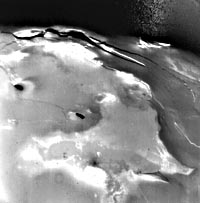 |
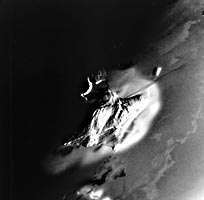 |
Some scarps appear to be normal fault scarps, notably the long straight ones in Figure P-13.3, bounding depressions. The continual and intense internal heating of Io probably keeps much of its interior molten, and the lithosphere is probably only a few tens of kilometers thick. Under such conditions, extensional tectonism and normal faulting should be widespread.
The geomorphology of Io as it is now may resemble that of the very primitive Earth, which must have been much hotter and more active in the earliest Archean than it is now. The inferred partly molten interior and thin lithosphere of Io resemble most concepts of the early Earth; perhaps the geomorphology of both bodies was similar. At a later stage, when the Earth cooled enough to permit rain and fluvial erosion, its landscape may have resembled that of the channeled Martian highlands (Plate P-8). Voyager P-21226.
Continue to Plate P-14| Chapter 10 Table of Contents.| Return to Home Page| Complete Table of Contents|